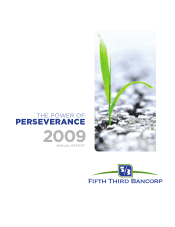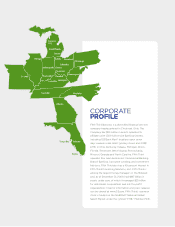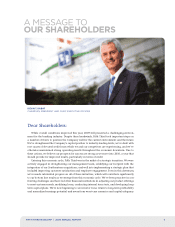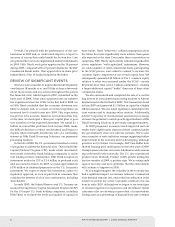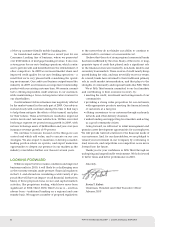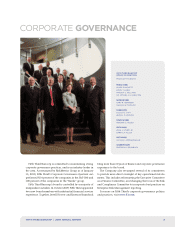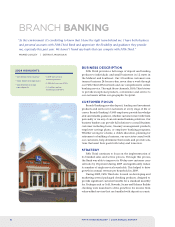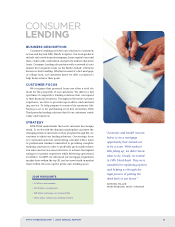Fifth Third Bank 2009 Annual Report Download - page 4
Download and view the complete annual report
Please find page 4 of the 2009 Fifth Third Bank annual report below. You can navigate through the pages in the report by either clicking on the pages listed below, or by using the keyword search tool below to find specific information within the annual report.
Overall, I’m pleased with the performance of our core
businesses in 2009 and, as credit trends improve, I expect to
see more of our top-line results benefit the bottom line. I am
also pleased that our stock outperformed industry benchmarks
in 2009. Fifth Third’s stock price appreciated by 18 percent
during 2009, compared with a 9 percent decline for the S&P
Commercial Banks index. That appreciation in share price
ranked third of the 14 banks included in the Index.
RevIEW OF SIGNIFICANT EVENTS
We have seen a number of unprecedented developments
over the past 18 months or so, and I’d like to share a few words
about those events and our actions throughout this period.
The financial crisis, which began in 2007, intensified in the
latter part of 2008. It has since surpassed any our industry
has experienced since the 1930s. In the first half of 2008, we
at Fifth Third concluded that the economic downturn was
likely to deepen and, as a result, we would experience an
increased level of credit losses into 2009. This expectation
has proven to be accurate. Based on our internal stress tests
at the time, we developed a three-part capital plan to posi-
tion ourselves for the expected downturn. We raised $1.1
billion in convertible preferred stock in June 2008, made
the difficult decision to reduce our dividend, and began to
explore what eventually became the sale of a controlling
interest in Fifth Third Processing Solutions, our payments
processing business.
In the fall of 2008, the U.S. government launched a variety
of programs to address the financial crisis. This included the
Capital Purchase Program (CPP), under which investments
were made in healthy bank holding companies to main-
tain lending in their communities. Fifth Third accepted an
investment under the CPP of $3.4 billion in preferred stock
and associated warrants. In 2009, we paid approximately
$170 million in dividend payments on the U.S. Treasury’s
investment. We expect to repay this investment, subject to
regulatory approval, as soon as practical in a manner that
considers the interests of all of our constituencies, including
shareholders.
In early 2009, the Federal Reserve and U.S. Treasury an-
nounced the Supervisory Capital Assessment Program (SCAP)
for the 19 largest U.S. bank holding companies, including
Fifth Third, to evaluate the levels and quality of capital for
these banks. These “stress tests” utilized assumptions about
the future that were significantly more adverse than gener-
ally expected at the time. Even under these conservative as-
sumptions, Fifth Third’s capital levels remained significantly
above regulatory “well-capitalized” minimums. However,
we, and a number of other commercial banks participating
in the SCAP process, were asked to commit to increase the
common equity component of our overall capital base. We
subsequently generated $2 billion of Tier 1 common equity,
relative to what was assumed under the SCAP – nearly
80 percent more than our $1.1 billion commitment – creating
a larger additional capital “buffer” than any of these other
commercial banks.
We also announced and completed the sale of a control-
ling interest in our payments processing business to Advent
International in the first half of 2009. This transaction closed
in June 2009 and generated $1.3 billion in capital in a highly
efficient manner. We also retain significant ownership in the
joint venture and its ongoing value creation. Additionally,
Advent’s expertise in international payments processing
increases the potential to unlock growth opportunities for Fifth
Third Processing Solutions in previously untapped markets.
As 2009 progressed, economic trends improved and our
results have significantly surpassed those assumed under
the government’s stress test adverse scenario. We’ve also
seen a number of early indicators emerge suggesting further
improvement in the economy may be developing, although
growth is not yet robust. For example, S&P Case-Shiller data
showed housing price stabilization in the latter part of 2009.
Unemployment also has seen some stabilization while remain-
ing at elevated levels nationally. The U.S. also experienced
positive Gross Domestic Product (GDP) growth during the
last few months of 2009, a positive sign. We’re seeing early
signs of recovery, and we’re optimistic that the environment
will continue to improve in 2010.
As you might imagine, the volatility in the economy has
had a significant impact on customer behavior. Commercial
loan demand remains low, and credit line utilization is the
lowest I’ve seen in my career. Customers continue to be cau-
tious in early 2010, although we’ve begun to see some signs
of renewed appetite for expansion and investment. Retail
customers also are showing a great deal of conservatism.
Savings rates as a percentage of disposable income continue
2FIFTH THIRD BANCORP | 2009 ANNUAL REPORT

